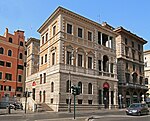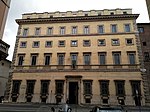Assassination of Julius Caesar

Julius Caesar, the Roman dictator, was assassinated by a group of senators on the Ides of March (15 March) of 44 BC during a meeting of the Senate at the Curia of Pompey of the Theatre of Pompey in Rome. The senators stabbed Caesar 23 times. They claimed to be acting over fears that Caesar's unprecedented concentration of power during his dictatorship was undermining the Roman Republic, and presented the deed as an act of tyrannicide. At least 60 senators were party to the conspiracy, led by Marcus Junius Brutus and Gaius Cassius Longinus. Despite the death of Caesar, the conspirators were unable to restore the institutions of the Republic. The ramifications of the assassination led to the Liberators' civil war and ultimately to the Principate period of the Roman Empire.
Excerpt from the Wikipedia article Assassination of Julius Caesar (License: CC BY-SA 3.0, Authors, Images).Assassination of Julius Caesar
Piazza dei Calcarari, Rome Municipio Roma I
Geographical coordinates (GPS) Address Nearby Places Show on map
Geographical coordinates (GPS)
| Latitude | Longitude |
|---|---|
| N 41.895277777778 ° | E 12.476944444444 ° |
Address
Area sacra dell'Argentina
Piazza dei Calcarari
00186 Rome, Municipio Roma I
Lazio, Italy
Open on Google Maps










